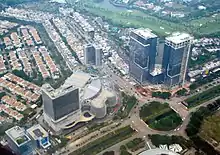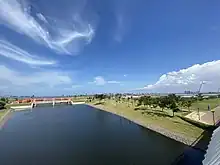
Pantai Indah Kapuk (PIK) (Chinese: 潘泰因达卡普克) is a gated community, located in parts of Penjaringan, North Jakarta and Kapuk, West Jakarta, Indonesia.[1] It is one of the most prestigious residential areas in Jakarta along with Menteng, Pondok Indah, and Puri Indah.[1]
PIK is often the most sought residential area for wealthy Chinese Indonesians, featuring large mansions in exclusive gated clusters. The area never floods, despite being in close proximity with flood-prone districts. Although most of Pantai Indah Kapuk is housing estates, there are businesses on the main roads such as Pantai Indah Utara, Pantai Indah Selatan, and Marina Indah. The Cordoba and Crown Golf shophouses on the Marina Indah Road are famous[2] for restaurants and cafes. PIK is one of Jakarta's nightlife districts. It's full of night clubs, discotheques, bars and cafes. PIK can be accessed from Jakarta Airport Toll Road and Jakarta Outer Ring Road West.
History

PIK was historically part of the particuliere landerij or private domain of Kapoek. The estate was owned by Tan Eng Goan, 1st Majoor der Chinezen of Batavia (1802 — 1872), and was later purchased by his successor (no relation), the 2nd Majoor Tan Tjoen Tiat (1816 — 1880).[3]
In the early 20th century, it became part of the landholdings of N.V. Landbouw Maatschappij Tan Tiang Po, a landholding company belonging to Majoor Tan Eng Goan's grandson-inlaw, Luitenant der Chinezen Tan Tiang Po and of the latter's son, Tan Liok Tiauw, Landheeren (or landlords) of Batoe-Tjepper.[4][5]
In 1988, the property developer Ciputra, backed by Indonesia's wealthiest man at the time Sudono Salim, acquired the area and developed today's housing estate of Pantai Indah Kapuk, earmarked as a wealthy suburb of gated communities.[6]
Controversy

The Pantai Indah Kapuk project in Jakarta, was criticized in interviews with various officials for its potentially negative environmental impact and incompatibility with existing regulations. According to a newspaper report, this 1,160-hectare complex has long sparked controversy as it was built in 1989 on an area formerly covered by mangrove forests and swamps. The construction of the project was approved by the then minister of forestry Hasjrul Harahap and then governor Wiyogo Atmodarminto. Several NGOs are planning to file a class action suit against the developer for causing floods in the nearby Penjaringan area. They accused the developer of violating the city’s land-use plan for building the complex on a protected green belt area. According to the city’s master land-use plan for 1985 and 2005, the location was still designated a green belt area. But, it was changed into a residential area in 1995. (Developer challenges public 2002).[7]
Education
- Singapore School (formerly Singapore International School)[8]
- Pelangi Kasih School
- Bina Bangsa School (培民学校)
- St. Nicholas School[9] (圣尼古拉学校)
- St. Johannes Berchmans[10]
See also

References
- 1 2 Nas, Peter J. M. (2005). Directors of Urban Change in Asia. Routledge. ISBN 9781134267378. Retrieved 20 November 2018.
- ↑ "Jakpost guide to Pantai Indah Kapuk". The Jakarta Post. Retrieved 2017-08-06.
- ↑ Lohanda, Mona (1994). The Kapitan Cina of Batavia, 1837-1942. Jakarta: Djambatan. Retrieved 19 October 2018.
- ↑ "Tan Tiang Po Landbouw". Colonial Business Indonesia (in Dutch). Universiteit Leiden. Retrieved 18 October 2017.
- ↑ Regeerings-Almanak voor Nederlandsch-Indie. 1927. University of California (April 27. 2009)
- ↑ Nas, Peter J. M. (2005). Directors of Urban Change in Asia. Routledge. ISBN 9781134267378. Retrieved 20 November 2018.
- ↑ Dieleman, M. New town development in Indonesia: Renegotiating, shaping and replacing institutions. Bijdragen tot de Taal-, Land- en Volkenkunde. Vol. 167, no. 1 pp. 60–85, 2011.
- ↑ SISPIK Homepage. Retrieved on May 8, 2015
- ↑ Saint Nicholas Homepage. Retrieved on Aug 29, 2015
- ↑ "Sekolah Kolese St. Johannes Berchmans Hadir di PIK 2 dengan Fasilitas Terbaik". SINDOnews.com (in Indonesian). Retrieved 2023-05-07.